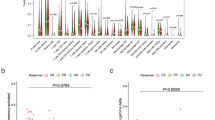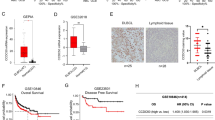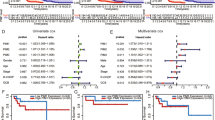Abstract
Background
The tumor microenvironment plays a crucial role in the oncogenesis and treatment of diffuse large B-cell lymphoma (DLBCL). The H3K9me3-specific histone methyltransferase Suppressor of variegation 3-9 homolog 1 (SUV39H1) is a significant gene that promotes the progression of various malignancies. However, the specific expression of SUV39H1 in DLBCL remains unclear.
Methods
By retrieving data from GEPIA, UCSC XENA and TCGA public databases, we observed the high expression of SUV39H1 in DLBCL. Combined with an immunohistochemical validation assay, we analyzed our hospital’s clinical characteristics and prognosis of 67 DLBCL patients. The results showed that high SUV39H1 expression was closely associated with age over 50 years (P = 0.014) and low albumin levels (P = 0.023) of patients. Furthermore, the experiments in vitro were deployed to evaluate the regulation of SUV39H1 on the DLBCL immune microenvironment.
Results
The results showed that high SUV39H1 expression was closely associated with age over 50 years (P = 0.014) and low albumin levels (P = 0.023) of patients. The prognostic analysis showed that the high SUV39H1 expression group had a lower disease-free survival (DFS) rate than the low SUV39H1 expression group (P < 0.05). We further discovered that SUV39H1 upregulated the expression of CD86+ and CD163+ tumor-associated macrophages by DLBCL patients’ tissues and cell experiments in vitro (P < 0.05). And SUV39H1-associated T lymphocyte subsets and cytokines IL-6/CCL-2 were downregulated in DLBCL (P < 0.05).
Conclusions
In summary, SUV39H1 might be not only a potential target for treating DLBCL but also a clinical indicator for doctors to evaluate the trend of disease development.





Similar content being viewed by others
Data availability
The datasets supporting the conclusions of this article are available in the Oncomine (https://www.oncomine.org/resource/login.html), Gene Expression Profiling Interactive Analysis (GEPIA, http://gepia.cancer-pku.cn/), Cancer Cell Line Encyclopedia (CCLE, https://portals.broadinstitute.org/ccle/), UALCAN (http://ualcan.path.uab.edu/), and The Cancer Genome Atlas (TCGA, https://www.cancer.gov/about-nci/organization/ccg/research/structural-genomics/tcga) databases.
References
Teras LR, DeSantis CE, Cerhan JR, Morton LM, Jemal A, Flowers CR. 2016 US lymphoid malignancy statistics by World Health Organization subtypes. CA Cancer J Clin. 2016;66(6):443–59.
Hans CP, Weisenburger DD, Greiner TC, Gascoyne RD, Delabie J, Ott G, et al. Confirmation of the molecular classification of diffuse large B-cell lymphoma by immunohistochemistry using a tissue microarray. Blood. 2004;103(1):275–82.
Xu PP, Fu D, Li JY, Hu JD, Wang X, Zhou JF, et al. Anthracycline dose optimisation in patients with diffuse large B-cell lymphoma: a multicentre, phase 3, randomised, controlled trial. Lancet Haematol. 2019;6(6):e328–37.
Li S, Young KH, Medeiros LJ. Diffuse large B-cell lymphoma. Pathology. 2018;50(1):74–87.
Bakhshi TJ, Georgel PT. Genetic and epigenetic determinants of diffuse large B-cell lymphoma. Blood Cancer J. 2020;10(12):123.
Nielsen SJ, Schneider R, Bauer UM, Bannister AJ, Morrison A, O’Carroll D, et al. Rb targets histone H3 methylation and HP1 to promoters. Nature. 2001;412(6846):561–5.
Dodge JE, Kang YK, Beppu H, Lei H, Li E. Histone H3–K9 methyltransferase ESET is essential for early development. Mol Cell Biol. 2004;24(6):2478–86.
Peters AH, O’Carroll D, Scherthan H, Mechtler K, Sauer S, Schöfer C, et al. Loss of the Suv39h histone methyltransferases impairs mammalian heterochromatin and genome stability. Cell. 2001;107(3):323–37.
Braig M, Lee S, Loddenkemper C, Rudolph C, Peters AH, Schlegelberger B, et al. Oncogene-induced senescence as an initial barrier in lymphoma development. Nature. 2005;436(7051):660–5.
Milanovic M, Fan DNY, Belenki D, Däbritz JHM, Zhao Z, Yu Y, et al. Senescence-associated reprogramming promotes cancer stemness. Nature. 2018;553(7686):96–100.
Pace L, Goudot C, Zueva E, Gueguen P, Burgdorf N, Waterfall JJ, et al. The epigenetic control of stemness in CD8(+) T cell fate commitment. Science. 2018;359(6372):177–86.
Shen JZ, Qiu Z, Wu Q, Finlay D, Garcia G, Sun D, et al. FBXO44 promotes DNA replication-coupled repetitive element silencing in cancer cells. Cell. 2021;184(2):352-369.e23.
Altieri F, Di Stadio CS, Federico A, Miselli G, De Palma M, Rippa E, et al. Epigenetic alterations of gastrokine 1 gene expression in gastric cancer. Oncotarget. 2017;8(10):16899–911.
Chiba T, Saito T, Yuki K, Zen Y, Koide S, Kanogawa N, et al. Histone lysine methyltransferase SUV39H1 is a potent target for epigenetic therapy of hepatocellular carcinoma. Int J Cancer. 2015;136(2):289–98.
Lu C, Yang D, Klement JD, Oh IK, Savage NM, Waller JL, et al. SUV39H1 represses the expression of cytotoxic T-lymphocyte effector genes to promote colon tumor immune evasion. Cancer Immunol Res. 2019;7(3):414–27.
Mo W, Liu Q, Lin CC, Dai H, Peng Y, Liang Y, et al. mtor inhibitors suppress homologous recombination repair and synergize with PARP inhibitors via regulating SUV39H1 in BRCA-proficient triple-negative breast cancer. Clin Cancer Res. 2016;22(7):1699–712.
Schleich K, Kase J, Dörr JR, Trescher S, Bhattacharya A, Yu Y, et al. H3K9me3-mediated epigenetic regulation of senescence in mice predicts outcome of lymphoma patients. Nat Commun. 2020;11(1):3651.
Vivian J, Rao AA, Nothaft FA, Ketchum C, Armstrong J, Novak A, et al. Toil enables reproducible, open source, big biomedical data analyses [J]. Nat Biotechnol. 2017;35(4):314–6.
Tang Z, Li C, Kang B, Gao G, Li C, Zhang Z. GEPIA: a web server for cancer and normal gene expression profiling and interactive analyses. Nucleic Acids Res. 2017;45(W1):W98–102.
Friedrichs K, Gluba S, Eidtmann H, Jonat W. Overexpression of p53 and prognosis in breast cancer. Cancer. 1993;72(12):3641–7.
Remmele W, Stegner HE. Immunhistochemischer Nachweis von Ostrogenrezeptoren (ERICA) in Mammakarzinomgewebe: Vorschlag zur einheitlichen Formulierung des Untersuchungs-befundes. Dtsch Arztebl. 1986;83:3362–4.
Wang J, Yin X, He W, Xue W, Zhang J, Huang Y. SUV39H1 deficiency suppresses clear cell renal cell carcinoma growth by inducing ferroptosis. Acta Pharm Sin B. 2021;11(2):406–19.
Djeghloul D, Kuranda K, Kuzniak I, Barbieri D, Naguibneva I, Choisy C, et al. Age-associated decrease of the histone methyltransferase SUV39H1 in HSC perturbs heterochromatin and B lymphoid differentiation. Stem Cell Rep. 2016;6(6):970–84.
Boonmee A, Benjaskulluecha S, Kueanjinda P, Wongprom B, Pattarakankul T, Palaga T. The chemotherapeutic drug carboplatin affects macrophage responses to LPS and LPS tolerance via epigenetic modifications. Sci Rep. 2021;11(1):21574.
Chen TT, Wu SM, Ho SC, Chuang HC, Liu CY, Chan YF, et al. SUV39H1 reduction is implicated in abnormal inflammation in COPD. Sci Rep. 2017;7:46667.
Wang J, Yan W, Peng X, Jiang Y, He L, Peng Y, et al. Functional role of SUV39H1 in human renal tubular epithelial cells under high-glucose ambiance. Inflammation. 2018;41(1):1–10.
Sudhahar V, Das A, Horimatsu T, Ash D, Leanhart S, Antipova O, et al. Copper transporter ATP7A (copper-transporting P-type ATPase/Menkes ATPase) limits vascular inflammation and aortic aneurysm development: role of microRNA-125b. Arterioscler Thromb Vasc Biol. 2019;39(11):2320–37.
Weng X, Zhang Y, Li Z, Yu L, Xu F, Fang M, et al. Class II transactivator (CIITA) mediates IFN-γ induced eNOS repression by enlisting SUV39H1. Biochim Biophys Acta Gene Regul Mech. 2019;1862(2):163–72.
Reimann M, Lee S, Loddenkemper C, Dörr JR, Tabor V, Aichele P, et al. Tumor stroma-derived TGF-beta limits myc-driven lymphomagenesis via Suv39h1-dependent senescence. Cancer Cell. 2010;17(3):262–72.
Iordanskiy S, Van Duyne R, Sampey GC, Woodson CM, Fry K, Saifuddin M, et al. Therapeutic doses of irradiation activate viral transcription and induce apoptosis in HIV-1 infected cells. Virology. 2015;485:1–15.
Dörr JR, Yu Y, Milanovic M, Beuster G, Zasada C, Däbritz JH, et al. Synthetic lethal metabolic targeting of cellular senescence in cancer therapy. Nature. 2013;501(7467):421–5.
Harro CM, Perez-Sanz J, Costich TL, Payne KK, Anadon CM, Chaurio RA, et al. Methyltransferase inhibitors restore SATB1 protective activity against cutaneous T cell lymphoma in mice. J Clin Invest. 2021;131(3): e135711.
Campaner S, Doni M, Verrecchia A, Fagà G, Bianchi L, Amati B. Myc, Cdk2 and cellular senescence: old players, new game. Cell Cycle. 2010;9(18):3655–61.
Park JW, Bae YS. Dephosphorylation of p53 Ser 392 enhances trimethylation of histone H3 Lys 9 via SUV39h1 stabilization in CK2 downregulation-mediated senescence. Mol Cells. 2019;42(11):773–82.
Fane M, Weeraratna AT. How the ageing microenvironment influences tumour progression. Nat Rev Cancer. 2020;20(2):89–106.
Ochi Y, Kazuma Y, Hiramoto N, Ono Y, Yoshioka S, Yonetani N, et al. Utility of a simple prognostic stratification based on platelet counts and serum albumin levels in elderly patients with diffuse large B cell lymphoma. Ann Hematol. 2017;96(1):1–8.
Pace L, Goudot C, Zueva E, Gueguen P, Burgdorf N, Waterfall JJ, et al. The epigenetic control of stemness in CD8+ T cell fate commitment. Science. 2018;359(6372):177–86.
Acknowledgements
Not applicable.
Funding
This study was supported by the National Natural Science Foundation of China (Grant No. 82070210) and Henan Provincial Science and Technology Research Project (Grant No. SBGJ202001008).
Author information
Authors and Affiliations
Contributions
Data curation, YZ, SQ, QW, YL, JG, XK, WW, ZW, HH and SW; Funding acquisition, MZ, XZ and QC; Investigation, YZ and SQ; Methodology, MZ and XZ; Resources, GW and WL; Software, YZ and CT; Supervision, MZ, XZ and QC; Writing—original draft, YZ; Writing—review and editing, QC. All the authors read and approved the final manuscript.
Corresponding authors
Ethics declarations
Conflict of interest
All the authors declare that they have no competing interests.
Ethical approval
The use of pathological specimens and clinical information of patients was approved by the Ethics Committee of Scientific Research and Clinical Trial of The First Affiliated Hospital of Zhengzhou University (approval no. 2022-KY-0038-002; Zhengzhou, China).
Consent to participate
The consents to participate in this study was provided by all the participants. This research has obtained the consent of all the participants. The privacy rights of human subjects must always be observed by all the authors.
Consent for publication
All the authors have read and consented to submit the article to this journal.
Additional information
Publisher's Note
Springer Nature remains neutral with regard to jurisdictional claims in published maps and institutional affiliations.
Yue Zhang and Siyu Qian are the two first authors.
Supplementary Information
Below is the link to the electronic supplementary material.
Rights and permissions
Springer Nature or its licensor (e.g. a society or other partner) holds exclusive rights to this article under a publishing agreement with the author(s) or other rightsholder(s); author self-archiving of the accepted manuscript version of this article is solely governed by the terms of such publishing agreement and applicable law.
About this article
Cite this article
Zhang, Y., Qian, S., Wen, Q. et al. SUV39H1 is a prognosis and immune microenvironment-related biomarker in diffuse large B-cell lymphoma. Clin Transl Oncol 25, 2438–2450 (2023). https://doi.org/10.1007/s12094-023-03128-2
Received:
Accepted:
Published:
Issue Date:
DOI: https://doi.org/10.1007/s12094-023-03128-2




